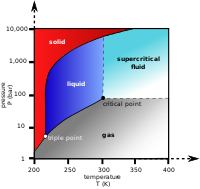
Photo from wikipedia
The demand for safe, high-quality food has greatly increased, in recent times. As traditional thermal pasteurization can significantly impact the nutritional value and the color of fresh food, an increasing… Click to show full abstract
The demand for safe, high-quality food has greatly increased, in recent times. As traditional thermal pasteurization can significantly impact the nutritional value and the color of fresh food, an increasing number of nonthermal pasteurization technologies have attracted attention. The bactericidal effect of high-pressure carbon dioxide has been known for many years, and its effect on food-related enzymes has been studied. This novel technology has many merits, owing to its use of relatively low pressures and temperatures, which make it a potentially valuable future method for nonthermal pasteurization. For example, the inactivation of polyphenol oxidase can be achieved with relatively low temperature and pressure, and this can contribute to food quality and better preserve nutrients, such as vitamin C. However, this novel technology has yet to be developed on an industrial scale due to insufficient test data. In order to support the further development of this application, on an industrial scale, we have reviewed the existing information on high-pressure carbon dioxide pasteurization technology. We include its bactericidal effects and its influence on food quality. We also pave the way for future studies, by highlighting key areas.
Journal Title: Food Engineering Reviews
Year Published: 2020
Link to full text (if available)
Share on Social Media: Sign Up to like & get
recommendations!